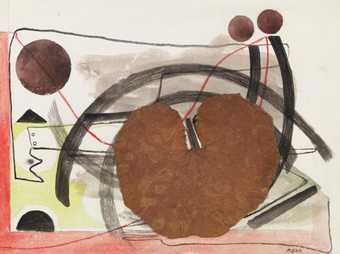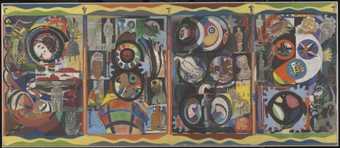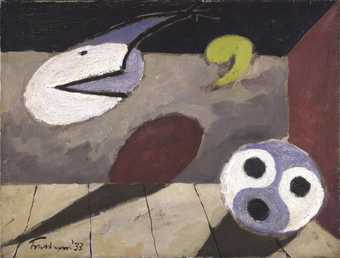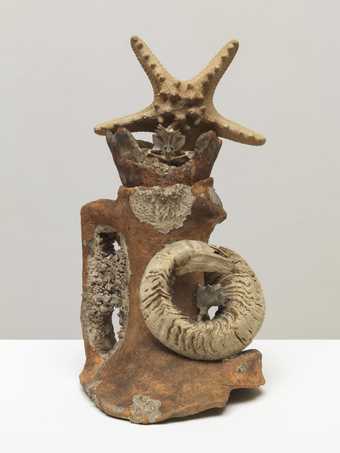
Not on display
- Artist
- Eileen Agar 1899–1991
- Medium
- Oil paint on canvas
- Dimensions
- Support: 1003 × 559 mm
frame: 1100 × 650 × 60 mm - Collection
- Tate
- Acquisition
- Purchased 1964
- Reference
- T00707
Summary
Agar wrote that Three Symbols was her first imaginative essay into Surrealism. It was painted while she was living in Paris with her future husband, Joseph Bard, between 1928-30. There she had lessons with the Czech painter Frantisek Foltyn (1891 - 1976) and met artists and poets, including André Breton (1896-1966) and Paul Eluard (1895-1952), who were already champions of Surrealism.
Agar was aware that her work needed a new direction and it was in this work that she began to move towards a more dedicated surrealist style. In this painting she combined three concepts, each represented by architecture. She explained,
In it, a pillar stands for Greek culture, Notre Dame is a symbol of Christianity, and a bridge built by Eiffel (the Tower man) symbolises modern technology reaching into the future and expressing time to come. It was my first attempt at an imaginative approach to painting, and although the result was in some ways surreal, it was not done with that intention. However, Surrealism was in the air, for painters and poets in France, and later in England, were kissing that sleeping beauty troubled by nightmares; and it was the kiss of life that they gave. (Agar, p.93)
The painting was first exhibited in 1964 at a retrospective exhibition entitled 'Paintings and Collages 1930-1964' at the Brook Street Gallery with the title Flying Pillar. Agar, however, claimed later that year that she preferred the original title, Three Symbols, which refers to all three elements (conversation of 21 December 1964).
Further reading:
Eileen Agar, A Look at My Life, in collaboration with Andrew Lambirth, London 1988, pp.93, 201.
Ann Simpson, with David Gascoyne and Andrew Lambirth, Eileen Agar 1899-1991, exhibition catalogue, Scottish National Gallery of Modern Art, Edinburgh 1999, pp.18, 32, no.12, reproduced plate 3, in colour.
Chloe Johnson
October 2001
Does this text contain inaccurate information or language that you feel we should improve or change? We would like to hear from you.
Display caption
This painting includes structures from three eras: a Greek column, a Gothic cathedral (Notre Dame) and a modern bridge. Agar claimed that this flight of the imagination was the first work in which she began to move towards a more surrealist style. She and her future husband, the writer Joseph Bard, were living in Paris at this time. It was there that they met André Breton and Paul Eluard, who, she later recalled, were among the poets and painters giving the ‘kiss of life’ to surrealism, ‘that sleeping beauty troubled by nightmares’.
Gallery label, November 2016
Does this text contain inaccurate information or language that you feel we should improve or change? We would like to hear from you.
Catalogue entry
Eileen Agar b. 1904
T00707 Three Symbols 1930
Inscr. ‘Agar’ b.r.
Canvas, 39½ x 22 (100 x 56).
Purchased from the Brook Street Gallery (Grant-in-Aid) 1964.
Exh: Retrospective Exhibition of Paintings and Collages 1930–64, Brook Street Gallery, October–November 1964 (repr., not numbered) as ‘Flying Pillar’.
The artist told the compiler (21 December 1964) that she would prefer the picture to be known as ‘Three Symbols’, her intention having been to represent three cultures, the ancient Greco-Roman world by the pillar, medieval Christianity by Notre Dame on the right, and modern technical inventions by the bridge built by Eiffel, which she had seen reproduced. It was her first imaginative essay, painted while she was still studying in Paris.
Published in The Tate Gallery Report 1964–1965, London 1966.
Explore
- abstraction(8,615)
-
- from recognisable sources(3,634)
- bridges and viaducts(4,123)
-
- viaduct(38)
- column(444)
- cathedral(741)
- France(3,508)
You might like
-
Eileen Agar The Reaper
1938 -
Eileen Agar Angel of Anarchy
1936–40 -
Eileen Agar The Autobiography of an Embryo
1933–4 -
Julian Trevelyan Basewall
1933 -
Eileen Agar Marine Object
1939





